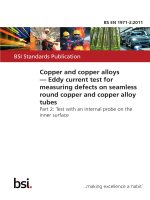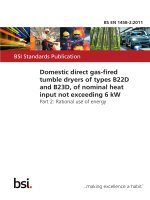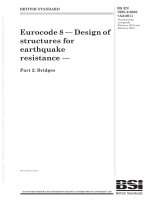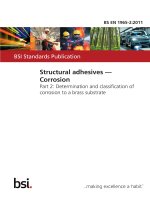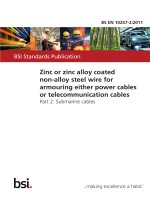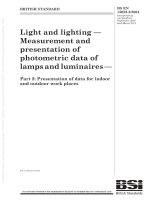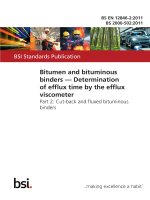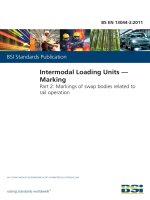Bsi bs en 62129 2 2011
Bạn đang xem bản rút gọn của tài liệu. Xem và tải ngay bản đầy đủ của tài liệu tại đây (1.38 MB, 66 trang )
BS EN 62129-2:2011
BSI Standards Publication
Calibration of
wavelength/optical
frequency measurement
instruments
Part 2: Michelson interferometer single
wavelength meters
BRITISH STANDARD
BS EN 62129-2:2011
National foreword
This British Standard is the UK implementation of EN 62129-2:2011. It is
identical to IEC 62129-2:2011.
The UK participation in its preparation was entrusted to Technical Committee
GEL/86, Fibre optics.
A list of organizations represented on this committee can be obtained on
request to its secretary.
This publication does not purport to include all the necessary provisions of a
contract. Users are responsible for its correct application.
© BSI 2011
ISBN 978 0 580 68591 0
ICS 33.180.30
Compliance with a British Standard cannot confer immunity from
legal obligations.
This British Standard was published under the authority of the Standards
Policy and Strategy Committee on 31 July 2011.
Amendments issued since publication
Amd. No.
Date
Text affected
BS EN 62129-2:2011
EUROPEAN STANDARD
EN 62129-2
NORME EUROPÉENNE
July 2011
EUROPÄISCHE NORM
ICS 33.180.30
English version
Calibration of wavelength/optical frequency measurement instruments Part 2: Michelson interferometer single wavelength meters
(IEC 62129-2:2011)
Etalonnage des appareils de mesure de
longueur d'onde/appareil de mesure de la
fréquence optique Partie 2: Appareils de mesure de longueur
d'onde unique à interféromètre de
Michelson
(CEI 62129-2:2011)
Kalibrierung von Messgeräten für die
Wellenlänge/optische Frequenz Teil 2: Michelson-InterferometerEinzelwellenlängen-Messgeräte
(IEC 62129-2:2011)
This European Standard was approved by CENELEC on 2011-06-30. CENELEC members are bound to comply
with the CEN/CENELEC Internal Regulations which stipulate the conditions for giving this European Standard
the status of a national standard without any alteration.
Up-to-date lists and bibliographical references concerning such national standards may be obtained on
application to the Central Secretariat or to any CENELEC member.
This European Standard exists in three official versions (English, French, German). A version in any other
language made by translation under the responsibility of a CENELEC member into its own language and notified
to the Central Secretariat has the same status as the official versions.
CENELEC members are the national electrotechnical committees of Austria, Belgium, Bulgaria, Croatia, Cyprus,
the Czech Republic, Denmark, Estonia, Finland, France, Germany, Greece, Hungary, Iceland, Ireland, Italy,
Latvia, Lithuania, Luxembourg, Malta, the Netherlands, Norway, Poland, Portugal, Romania, Slovakia, Slovenia,
Spain, Sweden, Switzerland and the United Kingdom.
CENELEC
European Committee for Electrotechnical Standardization
Comité Européen de Normalisation Electrotechnique
Europäisches Komitee für Elektrotechnische Normung
Management Centre: Avenue Marnix 17, B - 1000 Brussels
© 2011 CENELEC -
All rights of exploitation in any form and by any means reserved worldwide for CENELEC members.
Ref. No. EN 62129-2:2011 E
BS EN 62129-2:2011
EN 62129-2:2011
-2-
Foreword
The text of document 86/395/FDIS, future edition 1 of IEC 62129-2, prepared by IEC TC 86, Fibre optics,
was submitted to the IEC-CENELEC parallel vote and was approved by CENELEC as EN 62129-2 on
2011-06-30.
Attention is drawn to the possibility that some of the elements of this document may be the subject of
patent rights. CEN and CENELEC shall not be held responsible for identifying any or all such patent
rights.
The following dates were fixed:
– latest date by which the EN has to be implemented
at national level by publication of an identical
national standard or by endorsement
(dop)
2012-03-30
– latest date by which the national standards conflicting
with the EN have to be withdrawn
(dow)
2014-06-30
Annex ZA has been added by CENELEC.
__________
Endorsement notice
The text of the International Standard IEC 62129-2:2011 was approved by CENELEC as a European
Standard without any modification.
In the official version, for Bibliography, the following notes have to be added for the standards indicated:
IEC 60793-1-1
NOTE Harmonized as EN 60793-1-1.
IEC 60825-1
NOTE Harmonized as EN 60825-1.
IEC 60825-2
NOTE Harmonized as EN 60825-2.
__________
BS EN 62129-2:2011
EN 62129-2:2011
-3-
Annex ZA
(normative)
Normative references to international publications
with their corresponding European publications
The following referenced documents are indispensable for the application of this document. For dated
references, only the edition cited applies. For undated references, the latest edition of the referenced
document (including any amendments) applies.
NOTE When an international publication has been modified by common modifications, indicated by (mod), the relevant EN/HD
applies.
Publication
Year
Title
IEC 60050-300
2001
International Electrotechnical Vocabulary Electrical and electronic measurements and
measuring instruments Part 311: General terms relating to
measurements Part 312: General terms relating to electrical
measurements Part 313: Types of electrical measuring
instruments Part 314: Specific terms according to the type
of instrument
-
IEC 61315
2005
Calibration of fibre-optic power meters
EN 61315
2006
IEC/TR 61931
1998
Fibre optic - Terminology
-
-
ISO/IEC 17025
2005
General requirements for the competence of EN ISO/IEC 17025 2005
testing and calibration laboratories
ISO/IEC Guide 99
2007
International vocabulary of metrology - Basic and general concepts and associated terms
(VIM)
-
ISO/IEC Guide 98-3 2008
Uncertainty of measurement Part 3: Guide to the expression of uncertainty
in measurement (GUM:1995)
-
EN/HD
Year
–2–
BS EN 62129-2:2011
62129-2 IEC:2011
CONTENTS
INTRODUCTION ..................................................................................................................... 6
1
Scope ............................................................................................................................... 7
2
Normative references........................................................................................................ 7
3
Terms and definitions ....................................................................................................... 7
4
Preparation for calibration ............................................................................................... 11
5
4.1 Organization .......................................................................................................... 11
4.2 Traceability ............................................................................................................ 11
4.3 Advice for measurements and calibrations ............................................................. 11
4.4 Recommendations to customers ............................................................................ 12
Single wavelength calibration .......................................................................................... 12
5.1
5.2
5.3
6
General ................................................................................................................. 12
Establishing calibration conditions.......................................................................... 12
Calibration procedure ............................................................................................ 13
5.3.1 General ..................................................................................................... 13
5.3.2 Measurement configuration ........................................................................ 13
5.3.3 Detailed procedure..................................................................................... 15
5.3.4 Stability test (if necessary) ......................................................................... 15
5.3.5 "On/Off repeatability" measurement (optional if a specification is
available) ................................................................................................... 16
5.3.6 Wavelength dependence measurement (optional) ...................................... 18
5.3.7 Connector repeatability measurement (optional) ......................................... 19
5.4 Calibration uncertainty ........................................................................................... 20
5.5 Reporting the results ............................................................................................. 21
Absolute power calibration .............................................................................................. 21
Annex A (normative) Mathematical basis .............................................................................. 22
Annex B (informative) Rejection of outliers ........................................................................... 25
Annex C (informative) Example of a single wavelength calibration ........................................ 27
Annex D (informative) ITU wavelength bands ....................................................................... 30
Annex E (informative) Atomic and molecular reference transitions ........................................ 31
Annex F (informative) Reference locked laser example ......................................................... 42
Annex G (informative) Balance between accuracy and calibration time.................................. 44
Bibliography .......................................................................................................................... 46
Figure 1 – Example of a traceability chain.............................................................................. 10
Figure 2 – Wavelength meter measurement using a lock quality monitor signal ...................... 14
Figure 3 – Wavelength meter measurement using a reference wavelength meter ................... 14
Figure F.1 – Typical measurement arrangement to lock laser to gas absorption line ............... 43
Table 1 – Typical parameters to calculate the "On/Off repeatability" measurement
duration ................................................................................................................................ 17
Table B.1 – Critical values Z c as a function of sample size N ................................................. 26
Table C.1 – Type A uncertainty contributions for a stability measurement .............................. 27
Table C.2 – Uncertainty contributions for a "On/Off repeatability" measurement ..................... 28
BS EN 62129-2:2011
62129-2 IEC:2011
–3–
Table C.3 – Uncertainty budget for wavelength dependence .................................................. 28
Table C.4 – Uncertainty budget for the wavelength meter calibration ...................................... 29
Table D.1 – The ITU-T bands in different units ...................................................................... 30
Table E.1 – Helium-neon laser lines ...................................................................................... 32
Table E.2 – Centre vacuum wavelengths for Acetylene 12 C 2 H 2 .............................................. 33
Table E.3 – Frequency and vacuum wavelength values for the v 1 + v 3 and v 1 + v 2 + v 4 +
v 5 bands of 13 C 2 H 2 ................................................................................................................ 35
Table E.4 – List of H 13 CN transitions ..................................................................................... 38
Table E.5 – List of 12 C 1 6 O transitions.................................................................................... 40
Table E.6 – Excited state optogalvanic transitions ................................................................. 41
Table G.1 – Summary of choices ........................................................................................... 45
–6–
BS EN 62129-2:2011
62129-2 IEC:2011
INTRODUCTION
Wavelength meters, often based on the Michelson interferometer, are designed to measure the
wavelength of an optical source as accurately as possible. Although the wavelength meters
contain an internal absolute reference, typically a Helium-Neon laser, calibration is required to
achieve the highest accuracies. The instrument is typically used to measure wavelengths other
than that of the internal reference. Corrections are made within the instrument for the refractive
index of the surrounding air. A precise description of the calibration conditions must therefore
be an integral part of the calibration.
This international standard defines all of the steps involved in the calibration process:
establishing the calibration conditions, carrying out the calibration, calculating the uncertainty,
and reporting the uncertainty, the calibration conditions and the traceability.
The calibration procedure describes how to determine the ratio between the value of the input
reference wavelength (or the optical frequency) and the wavelength meter's result. This ratio is
called correction factor. The measurement uncertainty of the correction factor is combined
following Annex A from uncertainty contributions from the reference meter, the test meter, the
setup and the procedure.
The calculations go through detailed characterization of individual uncertainties. It is important
to know that:
a) estimations of the individual uncertainties are acceptable;
b) a detailed uncertainty analysis is only necessary once for each wavelength meter type
under test, and that all subsequent calibrations can be based on this one-time analysis;
c) some of the individual uncertainties can simply be considered to be part of a checklist, with
an actual value which can be neglected.
A number of optical frequency references can be used to provide a traceable optical frequency.
These are based on absorption by gas molecules under low pressure and using excited-state
opto-galvanic transitions in atoms. Annex E lists the lines.
BS EN 62129-2:2011
62129-2 IEC:2011
–7–
CALIBRATION OF WAVELENGTH/OPTICAL FREQUENCY
MEASUREMENT INSTRUMENTS –
Part 2: Michelson interferometer single wavelength meters
1
Scope
This part of IEC 62129 is applicable to instruments measuring the vacuum wavelength or
optical frequency emitted from sources that are typical for the fibre-optic communications
industry. These sources include Distributed Feedback (DFB) laser diodes, External Cavity
lasers and single longitudinal mode fibre-type sources. It is assumed that the optical radiation
will be coupled to the wavelength meter by a single-mode optical fibre. The standard describes
the calibration of wavelength meters to be performed by calibration laboratories or by
wavelength meter manufacturers. This standard is part of the IEC 62129 series on the
calibration of wavelength/optical frequency measurement instruments. Refer to IEC 62129 for
the calibration of optical spectrum analyzers.
2
Normative references
The following referenced documents are indispensable for the application of this document. For
dated references, only the edition cited applies. For undated references, the latest edition of
the referenced document (including any amendments) applies.
IEC 60050-300:2001, International Electrotechnical Vocabulary – Electrical and electronic
measurements and measuring instruments – Part 311: General terms relating to measurements
– Part 312: General terms relating to electrical instruments – Part 313: Types of electrical
measuring instruments – Part 314: Specific terms according to the type of instrument
IEC 61315 :2005, Calibration of fibre-optic power meters
IEC/TR 61931:1998, Fibre optic – Terminology
ISO/IEC 17025:2005, General requirements for the competence of testing and calibration
laboratories
ISO/IEC Guide 99:2007, International vocabulary of metrology – Basic and general concepts
and associated terms (VIM)
ISO/IEC Guide 98-3:2008, Uncertainty of measurement – Part 3: Guide to the expression of
uncertainty in measurement (GUM:1995)
3
Terms and definitions
For the purposes of this document, the following terms and definitions apply.
3.1
accredited calibration laboratory
calibration laboratory authorized by the appropriate national organization to issue calibration
certificates with a minimum specified uncertainty, which demonstrate traceability to national
standards
–8–
BS EN 62129-2:2011
62129-2 IEC:2011
3.2
adjustment
set of operations carried out on an instrument in order that it provides given indications
corresponding to given values of the measurand
[IEC 60050-300:2001 (311-03-16); see also ISO/IEC Guide 99:2007, 3.11, modified]
3.3
calibration
set of operations that establish, under specified conditions, the relationship between the values
of quantities indicated by a measuring instrument and the corresponding values realized by
standards
[ISO/IEC Guide 99:2007, 2.39, modified]
NOTE 1 The result of a calibration permits either the assignment of values of measurands to the indications or the
determination of corrections with respect to indications.
NOTE 2
A calibration may also determine other metrological properties such as the effect of influence quantities.
NOTE 3 The result of a calibration may be recorded in a document, sometimes called a calibration certificate or a
calibration report.
3.4
calibration conditions
conditions of measurements in which the calibration is performed
3.5
correction factor
CF
numerical factor by which the uncorrected result of a measurement is multiplied to compensate
for systematic error
[ISO/IEC Guide 99:2007, 2.53, modified]
3.6
detector
the element of the wavelength meter that transduces the radiant optical power into a
measurable, usually electrical quantity
[IEC/TR 61931 and ISO/IEC Guide 99:2007, 3.9, modified]
3.7
deviation
value minus its reference value
NOTE In this standard, the deviation is the difference between the indication of the test meter and the indication of
the reference meter when excited under the same conditions.
3.8
excitation (fibre-)
description of the distribution of optical power between the modes in the fibre
NOTE
Single mode fibres are generally assumed to be excited by only one mode (the fundamental mode).
3.9
instrument state
complete description of the state of the meter during the calibration
BS EN 62129-2:2011
62129-2 IEC:2011
–9–
3.10
measuring range
set of values of measurands for which the error of a measuring instrument is intended to lie
within specified limits
[ISO/IEC Guide 99:2007, 4.7, modified]
NOTE In this standard, the measuring range is the range of radiant power (part of the operating range), for which
the uncertainty at operating conditions is specified. The term "dynamic range" should be avoided in this context.
3.11
national (measurement) standard
standard recognized by a national decision to serve, in a country, as the basis for assigning
values to other standards of the quantity concerned
[ISO/IEC Guide 99:2007, 5.3, modified]
3.12
national standards laboratory
laboratory which maintains the national standard
3.13
natural standard
atomic or molecular transition that can be used to realise a reference standard
3.14
operating conditions
appropriate set of specified ranges of values of influence quantities usually wider than the
reference conditions for which the uncertainties of a measuring instrument are specified
[ISO/IEC Guide 99:2007, 4.9, modified]
NOTE The operating conditions and uncertainty at operating conditions are usually specified by manufacturer for
the convenience of the user.
3.15
operating range
specified range of values of one of a set of operating conditions
3.16
optical input port
physical input of the wavelength meter (or standard) to which the radiant power is to be applied
or to which the optical fibre end is to be connected. An optical path (path of rays with or without
optical elements like lenses, diaphragms, light guides, etc.) is assumed to connect the optical
input port with the detector
3.17
reference conditions
conditions of use prescribed for testing the performance of a measuring instrument or for
intercomparison of results of measurements
[ISO/IEC Guide 99:2007, 4.11, modified]
NOTE The reference conditions generally include reference values or reference ranges for the influence quantities
affecting the measuring instrument.
3.18
reference wavelength meter
standard which is used as the reference to calibrate a test wavelength meter
BS EN 62129-2:2011
62129-2 IEC:2011
– 10 –
3.19
reference source
laser stabilized by reference to an atomic or molecular transition, or a stabilized frequency
comb, of known frequency/wavelength
3.20
reference standard
standard, generally having the highest metrological quality available at a given location or in a
given organization, from which measurements made there are derived
[ISO/IEC Guide 99:2007, 5.6, modified]
3.21
test meter
wavelength meter (or standard) to be calibrated by comparison with the reference wavelength
meter or the reference standard
3.22
traceability
property of the result of a measurement or the value of a standard whereby it can be related to
stated references, usually national or international standards, through an unbroken chain of
comparisons all having stated uncertainties
[ISO/IEC Guide 99:2007, 2.41, modified]
3.23
traceability chain
unbroken chain of comparison (see Figure 1)
[ISO/IEC Guide 99:2007, 2.41 and 2.42, modified]
National
standard
National standards laboratory
Working
standard
Accredited calibration laboratory
Transfer
standard
Calibration laboratory of company
Working
standard
Test Meter
IEC 1144/11
Figure 1 – Example of a traceability chain
3.24
wavelength meter (Michelson interferometer single-)
instrument, based on a Michelson interferometer, capable of measuring the wavelength of one
source
BS EN 62129-2:2011
62129-2 IEC:2011
– 11 –
NOTE Certain instrument designs can also measure the input power but with a larger uncertainty than most power
meters.
3.25
working standard
standard that is used routinely to calibrate measuring instruments
[ISO/IEC Guide 99:2007, 5.7, modified]
NOTE
4
4.1
A working standard is usually calibrated against a reference standard.
Preparation for calibration
Organization
The calibration laboratory should satisfy requirements of ISO/IEC 17025.
There shall be a documented measurement procedure for each type of calibration performed,
giving step-by-step operating instructions and equipment to be used.
4.2
Traceability
The requirements of ISO/IEC 17025 should be met.
All standards used in the calibration process shall be calibrated according to a documented
programme with traceability to national standards laboratories or to accredited calibration
laboratories. It is advisable to maintain more than one standard on each hierarchical level, so
that the performance of the standard can be verified by comparisons on the same level. Make
sure that any other test equipment which has a significant influence on the calibration results is
calibrated. Upon request, specify this test equipment and its traceability chain(s). The recalibration period(s) shall be defined and documented.
4.3
Advice for measurements and calibrations
This subclause gives general advice for all measurements and calibrations of wavelength
meters.
The calibration should be made in a temperature-controlled environment. The recommended
temperature is 23 °C. Depending on the desired uncertainty, the temperature, atmospheric
pressure and humidity may need to be monitored during the measurement, as the air refractive
index is a function of these parameters. Humidity control may be necessary to ensure that the
environment is within the operating specification of the instrument.
The laboratory should be kept clean. Connectors and optical input ports should always be
cleaned before measurement. The quality and cleanness of the connector in front of the
wavelength meter should be checked. The wavelength meter is a precision mechanical
instrument and so the fibre should be moved to the instrument rather than the other way round
as required for power meter calibrations.
Laser diodes are sensitive to back reflections. To improve stability, it is advisable to use an
optical isolator between the laser diode and the test meter.
For instruments that also report optical power, refer to IEC 61315 for calibration procedures. It
is important to note that optical sources such as extended cavity laser diodes that may have a
narrow linewidth (e.g. 50 kHz) and therefore give rise to a long coherence length. Coherent
reflections will add as the vector sum of the electric fields rather than the sum of the optical
powers.
– 12 –
BS EN 62129-2:2011
62129-2 IEC:2011
The use of a reference source based on a natural standard will yield lower uncertainties than
calibrations made using a reference wavelength meter.
4.4
Recommendations to customers
A single wavelength meter calibration within an ITU band (see Annex D) is expected to be
sufficient for that band. The increase in uncertainties due to extrapolation of the calibration to
adjacent bands must be determined for each design of instrument.
5
5.1
Single wavelength calibration
General
The wavelength calibration of the wavelength meter is based on a comparison with a reference
standard and the uncertainty comprises the contribution of the stability of the instrument under
test, its "On/Off repeatability," its wavelength dependence and the optical connector
repeatability.
The correction is based on the calibration result.
The "On/Off repeatability" measurement provides a contribution to the instrument uncertainty
calculation. The repeatability of the stabilization of the internal wavelength reference and the
stability of the optical alignment are the main contributors to this uncertainty contribution.
The measurement of the wavelength dependence also provides a contribution to the instrument
uncertainty calculation. This measurement has several purposes.
a) To verify that the correction for the air refractive index has been correctly implemented
within the instrument.
b) To determine the uncertainty contributions caused by numerical truncation errors.
c) To determine the uncertainty contributions caused by the finite optical path length within the
test instrument.
d) To determine systematic alignment effects such as wavelength dependent beam steering.
The calibration can be performed either using a reference source with a lock quality monitor or
using a reference wavelength meter.
Acquiring the measurement results under computer control is highly recommended.
5.2
Establishing calibration conditions
Establishing and maintaining the calibration conditions is an important part of the calibration,
because any change in these conditions is capable of producing erroneous measurement
results. The calibration conditions should be a close approximation to the intended operating
conditions. This ensures that the (additional) uncertainty in the operating environment is as
small as possible. The calibration conditions should be specified in the form of nominal values
with uncertainties when applicable. In order to meet the requirements of this standard, the
calibration conditions shall at least consist of
a) the date of calibration,
b) the ambient temperature, with uncertainty, for example 23 °C ± 1 °C. The temperature may
need to be monitored continuously to ensure that it remains within the prescribed limits,
c) the atmospheric pressure, for example 1020 hPa to1025 hPa. The atmospheric pressure
may need to be monitored continuously to ensure that it remains within the prescribed
limits,
BS EN 62129-2:2011
62129-2 IEC:2011
– 13 –
d) the ambient relative humidity, for example 30 % to 50 %. The ambient relative humidity may
need to be monitored continuously to ensure that it remains within the prescribed limits. A
relative humidity below the condensation point is assumed by default,
e) the input optical power (that must fall within the allowable specification for the instruments),
f)
the connector and polishing type,
g) details of the reference material or its identification number. Examples have been taken for
a gas absorption cell:
1) gas and isotope, e.g. 13 C 2 H 2
2) path length, e.g. 15 cm
3) pressure within the vessel, e.g. 1 000 Pa
4) transition, e.g. R(21)
h) the centre vacuum wavelength or frequency of the exciting source with its uncertainty,
i)
if a transition locked source is used then the quality of the lock must be continuously
monitored during the measurements; a lock indicator can be sufficient.
NOTE The above conditions may not be exhaustive. There may be other parameters that have a significant
influence on the measurement uncertainty and therefore should also be reported.
5.3
5.3.1
Calibration procedure
General
a) Establish and record the appropriate calibration conditions (see 5.2). Switch on all
instrumentation and wait for enough time to stabilize.
b) Set up the reference source.
c) In some of the older instrument designs a connector-adapter combination is used to couple
light from the optical fibre into the instrument. A fraction of the light from the reference
signal, typically a helium-neon laser, is emitted from the instrument. This beam defines the
optical axis for the interferometer. Maximizing the residual reference signal from the test
wavelength meter optimises the alignment of the connector-adapter. The optical power
must be measured using a linear power meter.
d) Set up the instrument state of the test wavelength meter according to the instruction
manual. Select appropriate units.
e) Record the instrument states of the wavelength meter.
5.3.2
Measurement configuration
Figure 2 shows the configuration using a reference source S with a lock-quality monitor Q. The
temperature, pressure and humidity of the environment may need to be monitored. The
refractive index change due to humidity is less than ±4 × 10 -7 at 1 550 nm. Monitoring of the
relative humidity is optional and is required only to achieve the best specification.
BS EN 62129-2:2011
62129-2 IEC:2011
– 14 –
IEC 1145/11
Key
C
controlling computer
P
reference power meter
F
optical fibre link
Q
lock quality monitor
I
computer interface connection
S
reference source
M
monitor link
W
test wavelength meter
Figure 2 – Wavelength meter measurement using a lock quality monitor signal
In the absence of a lock quality signal from the source, a reference wavelength meter must be
used to monitor the lock quality (Figure 3). If the lock has been lost, the results drift
considerably compared to the locked condition. It is important that the measurements are
performed simultaneously on both the reference and the test wavelength meters.
IEC 1146/11
Key
C
controlling computer
R
reference wavelength meter
F
optical fibre link
S
reference source
I
computer interface connection
W
test wavelength meter
P
reference power meter
NOTE The reference power meter may be used at locations X or Y to measure the optical power incident either on
the test or on the reference wavelength meters.
Figure 3 – Wavelength meter measurement using a reference wavelength meter
BS EN 62129-2:2011
62129-2 IEC:2011
5.3.3
– 15 –
Detailed procedure
The number of measurements averaged per reading affects the size of the results file, the
rejection of data by the measurement routine and detection of lock failure. A large number of
samples per measurement will increase the size of the data set used to check that the extreme
data points are valid. If the number of samples is too large then the temporal resolution will be
reduced. Also, loss of lock may not be detected. Typically, 50 samples (n) are taken per
measurement. The same methodology used in 5.3.5 can be applied to determine the optimum
value for n. The statistical rejection of outlying points (Annex B) is strongly recommended.
The measurement process is as follows.
a) Allow the equipment to reach equilibrium.
b) Configure the data acquisition software.
c) Ensure that the optical source is locked and is operating correctly.
d) Run the data acquisition software.
The correction factor is determined from the ratio of the mean values from each measurement:
λref
1 n λref i
=
CF = ∑
n i =1 λtest i λtest
(1)
where λref is the reference wavelength and λtest is the wavelength measured by the test
wavelength meter. The uncertainty associated with the correction factor should be expressed
as a dimensionless quantity. We can also determine the deviation D as in Equation (2). The
uncertainty associated with the deviation should be expressed as a length quantity.
D=
5.3.4
1 n
∑ (λtest i − λref i ) = λtest − λref
n i =1
(2)
Stability test (if necessary)
The stability of the instrument measuring a single wavelength under normal operating
conditions is measured to determine the instrument drift and its contribution to the uncertainty.
The measurement duration must be longer than 1 hour (12 hours is recommended). The
statistical rejection of outlying points (Annex B) is strongly recommended.
As for the calibration, the number of measurements averaged per reading affects the size of
the results file, the rejection of data by the measurement routine and detection of lock failure. A
large number of samples per measurement will increase the size of the data set used to check
that the extreme data points are valid. If the number of samples is too large then the temporal
resolution will be reduced. Also, loss of lock may not be detected. Typically, 50 samples (n) are
taken per measurement. The same methodology used in 5.3.5 can be applied to determine the
optimum value for n.
The measurement process is as follows:
a) Allow the equipment to reach equilibrium.
b) Configure the data acquisition software.
c) Ensure that the optical source is locked and is operating correctly.
d) Run the data acquisition software.
If the stability test is done during the calibration, the correction factor should be calculated
using these results. If the instrument is not stable, the calibration will not be valid.
BS EN 62129-2:2011
62129-2 IEC:2011
– 16 –
The mean centre wavelength for the n measurements of each data point of the stability test is
given by:
λsi =
1 n
∑ λstesti, j
n j =1
(3)
th
where λs i is the mean wavelength for the i stability measurement (i = 1…N) comprising each
of n measurements (j = 1 …n) and λstest i,i is the measured value.
The contribution of the type A standard uncertainty of each centre wavelength measurement is
given by Equation (4) (from Equation (A.3)).
n
1
(λstesti, j − λsi )2
ustesti =
∑
(n −1)n j =1
1/ 2
(4)
The uncertainty contribution due to stability can be calculated from Equation (5) and Equation
(6).
λs =
1 N
∑ λsi
N i =1
N
1
1
us =
(λsi − λs ) 2 +
∑
N
( N − 1) i =1
(5)
1
2
2
ustest
∑
i
i =1
N
(6)
where us is the uncertainty contribution from the stability measurement and N is the number of
data points of stability measurements. The number of measurements n for each data point of
the stability measurements should be chosen to be sufficiently large such that the second term
in Equation (6) becomes negligible in relation to the first term, giving Equation (7).
1
N
1
2
(λsi − λs ) 2
us =
∑
( N − 1) i =1
5.3.5
5.3.5.1
(7)
"On/Off repeatability" measurement (optional if a specification is available)
General
The measurements using a fixed wavelength reference source may be affected by the "On/Off
repeatability" of the wavelength meter internal reference. This test is optional if already done in
a qualification of the product. This test may be combined with the connector repeatability
measurement (5.3.7) in order to simplify the overall calibration process.
The duration of each measurement must be sufficient that its measurement uncertainty will not
significantly increase the uncertainty of the result. The uncertainty contribution determined from
this measurement will comprise of a component due to the "On/Off repeatability" of the
instrument and a component due to the measurement noise. Averaging is required to ensure
that the dominant component of the uncertainty contribution is due to the "On/Off repeatability"
of the instrument. The number of averages will depend on the measurement noise and can be
calculated using Equation (8). Typical parameters are given in Table 1.
BS EN 62129-2:2011
62129-2 IEC:2011
– 17 –
n=
2
σ rms
(8)
2
σ target
where n is the number of averages for each measurement, σ rms and σ target are the estimated
rms and target noise contributions. The statistical rejection of outlying points (Annex B) is
strongly recommended.
Table 1 – Typical parameters to calculate the "On/Off repeatability"
measurement duration
Parameter
5.3.5.2
Value
Estimated rms noise
1 pm
Target uncertainty contribution
0,05 pm
Number of averages required
400
Measurement rate
1 s -1
Duration
7 min
Measurement process
a) Allow the equipment to reach equilibrium.
b) Configure the data acquisition software.
c) Power down the wavelength meter and ensure that the reference source has turned off
completely.
d) Wait at least 10 min.
e) Turn on the wavelength meter and wait for it to complete its self-checks and stabilization of
its reference laser. The time taken for the system to achieve maximum stability may be as
long as 1 to 2 h, see manufacturers instructions for guidance.
f)
Measure the wavelength using data acquisition software to acquire n measurements.
g) Turn the wavelength meter off.
h) Repeat from c) until at least N sets of measurements have been made.
i)
"On/Off repeatability" measurement is complete.
The mean centre wavelength for the n measurements of each cycle of the "On/Off repeatability"
test is given by:
λrepi =
1
n
n
∑ λtesti, j
(9)
j =1
th
where λrep i is the mean wavelength for the i "On/Off repeatability" measurement (i = 1…N)
comprising each of n measurements (j = 1 …n) and λtest is the measured value.
The contribution of the type A standard uncertainty of each centre wavelength measurement is
given by Equation (10) (from Equation (A.3)).
n
1
λtest i, j − λrepi 2
utest i =
( n −1)n j =1
∑(
)
1/ 2
(10)
BS EN 62129-2:2011
62129-2 IEC:2011
– 18 –
The uncertainty contribution due to "On/Off repeatability" can be calculated from Equation (11)
and Equation (12).
λrep =
1
N
N
∑ λrepi
(11)
i =1
N
1
1
urep =
(λrepi − λrep) 2 +
∑
N
( N − 1) i =1
1
2
utest
∑
i =1
N
2
i
(12)
where urep is the uncertainty contribution from the "On/Off repeatability" measurement and N is
the number of sets of "On/Off repeatability" measurements. The number of measurements n for
each cycle of the “On/Off repeatability” measurements should be chosen to be sufficiently large
such that the second term in Equation (12) becomes negligible in relation to the first term,
giving Equation (13).
1
N
1
2
(λrepi − λrep) 2
urep =
∑
( N − 1) i =1
5.3.6
5.3.6.1
(13)
Wavelength dependence measurement (optional)
General
Measurements made over a range of wavelengths will provide an improved correction factor
and an improved estimate for the instrument uncertainty. The measurements require a number
of transition-locked reference sources, a single source that can be locked to a number of
transitions or multiple lines of a frequency comb of known values. This test is not required if the
wavelength meter under test is to be used in only one ITU-T band, unless the highest levels of
accuracy are required.
The number of measurements for each of the wavelength dependence measurements is
calculated using Equation (8).
5.3.6.2
Measurement process
a) Allow the equipment to reach equilibrium.
b) Configure the data acquisition software.
c) Either lock the laser to the reference transition and allow sufficient time for the system to
stabilize or connect each of transition-locked references in turn.
d) Measure the wavelength using data acquisition software to acquire n measurements.
e) Reset the wavelength of the reference source.
f)
Repeat from c) until N sets of wavelengths, (suggested minimum of 3) have been
measured.
g) The wavelength dependence measurement is now complete.
The mean centre wavelength for n measurements is given by:
λwd i =
1
n
n
∑ λwtesti, j
(14)
j =1
th
(i = 1…N) performing n
where λwd i is the mean wavelength for the i wavelength
measurements (j = 1...n) for each and λwtest is the measured value.
BS EN 62129-2:2011
62129-2 IEC:2011
– 19 –
The uncertainty of each centre wavelength measurement is given by Equation (15).
1
uwtest i =
( n −1)n
n
∑ (λwtesti, j − λwd i )
j =1
1/ 2
2
(15)
The wavelength deviation D i is defined in Equation (16).
Di = λwd i − λref i
(16)
The uncertainty contribution due to wavelength dependence can be calculated from Equation
(17) and Equation (18).
D=
1
N
N
∑D
i =1
(17)
i
1 N
1
uwd =
( Di − D) 2 +
∑
N
N − 1 i =1
1
2
2
uwtest
∑
i
i =1
N
(18)
where uwd is the uncertainty contribution from the wavelength dependence measurement and N
is the number of wavelengths. The number of measurements n for each cycle of the
wavelength dependence measurements should be chosen to be sufficiently large such that the
second term in Equation (18) becomes negligible in relation to the first term, giving Equation
(19).
1
2
1 N
( Di − D) 2
uwd =
∑
N − 1 i =1
5.3.7
5.3.7.1
(19)
Connector repeatability measurement (optional)
General
The connector repeatability measurement is required if the optical input to the wavelength
meter couples directly to the interferometer, without an intervening optical fibre link. The
premise is that small displacements of the optical fibre connector will cause changes to the
optical alignment between the reference and unknown optical beams. This test may be
combined with the “On/off repeatability” measurement (5.3.5) in order to simplify the overall
calibration process.
The number of measurements for each of the connector repeatability measurements is
calculated using Equation (8).
5.3.7.2
Measurement process
a) Allow the equipment to reach equilibrium.
b) Configure the data acquisition software.
c) Measure the wavelength using data acquisition software to acquire n measurements.
d) Disconnect the optical fibre from the wavelength meter.
e) Reconnect the optical fibre to the wavelength meter.
f)
Repeat from c) until N sets of measurements, typically 10, have been made.
BS EN 62129-2:2011
62129-2 IEC:2011
– 20 –
g) The connector repeatability measurement is now complete.
The mean centre wavelength for n measurements is given by:
1
n
λconi =
n
∑ λctesti, j
(20)
j =1
th
where λcon i is the mean wavelength for the i connector repeatability measurement (i = 1…N)
performing n measurements (j = 1...n) for each and λctest is the measured value.
The uncertainty of each connexion measurement is given by Equation (21).
1
uctest i =
( n −1)n
n
∑ (λctesti, j − λconi )
j =1
1/ 2
2
(21)
The uncertainty contribution due to connector repeatability can be calculated from Equation
(22) and Equation (23).
λcon =
1
N
N
∑ λconi
(22)
i =1
1
N
1 N
2
1
(λconi − λcon)2 +
ucon =
uctesti2
N i =1
N − 1 i =1
∑
∑
(23)
where ucon is the uncertainty contribution from the connector measurement and N is the
number of sets of measurements. The number of measurements n for each cycle of the
connector repeatability measurements should be chosen to be sufficiently large such that the
second term in Equation (23) becomes negligible in relation to the first term, giving Equation
(24).
1
2
1 N
(λconi − λcon) 2
ucon =
∑
N − 1 i =1
5.4
(24)
Calibration uncertainty
Note that the following list may not be complete. Additional contributions may have to be taken
into account, depending on the measurement setup and procedure. The mathematical basis,
Annex A, should be used to calculate and state the uncertainty.
a) Stability measurement
b) "On/Off repeatability" measurement
c) Wavelength dependence measurement
d) Connector repeatability
e) Uncertainty of the reference standard
f)
Source uncertainty (how well the source is stabilized to the natural standard)
g) Display resolution of the test wavelength meter
BS EN 62129-2:2011
62129-2 IEC:2011
5.5
– 21 –
Reporting the results
The results of each calibration should be reported as required by ISO/IEC 17025. Calibration
certificates referring to this standard shall at least include the following information:
a) All calibration conditions of the calibration process as described in 5.2.
b) The test meter's correction factor(s) or deviation(s), if the test meter was not adjusted.
c) On receipt correction factors or deviations and after adjustment correction factors or
deviations in the case that an adjustment was carried out.
d) The calibration uncertainty in the form of an expanded uncertainty as described in 5.4 and
Annex A.
e) The instrument state of the test meter during the calibration.
f)
Evidence that the measurements are traceable (see ISO/IEC 17025:2005, 5.10.4.1 c).
6
Absolute power calibration
If the wavelength meter has a power measurement capability then it must be calibrated using
the power meter calibration procedure (IEC 61315), while taking into account the restrictions
on moving the instrument (4.3).
BS EN 62129-2:2011
62129-2 IEC:2011
– 22 –
Annex A
(normative)
Mathematical basis
A.1
General
This annex summarizes the form of evaluating, combining and reporting the uncertainty of
measurement. It is based on the ISO/IEC Guide 98-3:2008, Uncertainty of measurement – Part
3: Guide to the expression of uncertainty in measurement (GUM:1995). It does not relieve the
need to consult this guide for more advice.
This document distinguishes two types of evaluation of uncertainty of measurement. Type A is
the method of evaluation of uncertainty by the statistical analysis of a series of measurements
on the same measurand. Type B is the method of evaluation of uncertainty based on other
knowledge.
A.2
Type A evaluation of uncertainty
The type A evaluation of standard uncertainty can be applied when several independent
observations have been made for a quantity under the same conditions of measurement.
For a quantity X estimated from n independent repeated observations X i , the arithmetic mean
is:
X=
1 n
∑ Xi .
n i =1
(A.1)
This mean is used as the estimate of the quantity, that is x = X . The experimental standard
deviation of the observations is given by:
1 n
(X i − X )2
s( X ) =
∑
n −1 i =1
1/ 2
(A.2)
where
X is the arithmetic mean of the observed values;
X i are the measurement samples of a series of measurements;
n
is the number of measurements, it is assumed to be large, for example, n ≥ 10.
The type A standard uncertainty u typeA (x) associated with the estimate x is the experimental
standard deviation of the mean:
u typeA ( x ) = s( X ) =
s( X )
n
(A.3)
BS EN 62129-2:2011
62129-2 IEC:2011
A.3
– 23 –
Type B evaluation of uncertainty
The type B evaluation of standard uncertainty is the method of evaluating the uncertainty by
means other than the statistical analysis of a series of observations. It is evaluated by scientific
judgement based on all available information on the variability of the quantity.
If the estimate x of a quantity X is taken from a manufacturer’s specification, calibration
certificate, handbook, or other source and its quoted uncertainty U(x) is stated to be a multiple
k of a standard deviation, the standard uncertainty u(x) is simply the quoted value divided by
the multiplier.
u(x) = U(x) / k
(A.4)
If only upper and lower limit X max and X min can be estimated for the value of the quantity X (for
example a manufacturer’s specifications or a temperature range), a rectangular probability
distribution is assumed; the estimated value is
x=
1
( X max + X min )
2
(A.5)
and the standard uncertainty is
u( x ) =
1
2 3
( X max − X min )
(A.6)
The contribution to the standard uncertainty associated with the output estimate y resulting
from the standard uncertainty associated with the input estimate x is
u(y) = c ∙ u(x)
(A.7)
where c is the sensitivity coefficient associated with the input estimate x.
A.4
Determining the combined standard uncertainty
The combined standard uncertainty is used to collect a number of individual uncertainties into a
single number. The combined standard uncertainty is based on statistical independence of the
individual uncertainties; it is calculated by root-sum-squaring all standard uncertainties
obtained from type A and type B evaluation:
uc ( y ) =
N
∑ u ( y)
i =1
2
i
(A.8)
where
i
is the current number of individual contribution;
u i (y)
are the standard uncertainty contributions;
N
is the number of uncertainties.
NOTE It is acceptable to neglect uncertainty contributions to this equation which are smaller than 1/10 of the
largest contribution, because squaring them will reduce their significance to 1/100 of the largest contribution.
